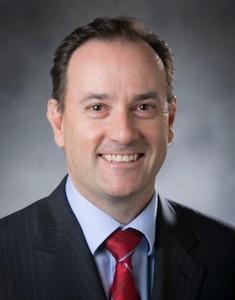
Research being conducted by members of the Duke Neurology Department spans from the subcellular to the population level. Basic and translational research in our Division of Translational Brain Sciences and other divisions are uncovering the complex genetic and metabolic interactions that lead to neurodegenerative disease, and identifying molecules that may lead to new therapies. Meanwhile our clinician scientists examine data from thousands of patients across health systems and the world to understand how to better treat and prevent stroke, epilepsy, and other conditions.
When Simon Gregory, PhD, became our Vice Chair for Research last year, he took on the challenge of maintaining and building on all of these efforts while also navigating the challenges of the spreading COVID-19 pandemic. In this interview Gregory discusses his top priorities for 2021, how his own background as a neurogenomicist influences his work, and the developments he’s most looking forward to in the next five to 10 years.
What are your roles and responsibilities as Vice Chair for Research?
I feel that the role of the Vice Chair for Research is to facilitate the already excellent work that’s going on within the Department, identify where we can grow our research mission, and enable connections between our basic, clinical, and physician scientists to explore research opportunities.
What are your top priorities as Vice Chair for 2021?
Having spoken to Department Chair Rich O’Brien, MD, PhD, our division chiefs, and research thought leaders within the Department, it was clear that we can work on things straight out of the gate. First of all I wanted to develop training opportunities for our staff.
I worked with third-year resident Elijah Lackey, MD, to identify research opportunities to residents within our departmental researchers (three of which we’ve already matched) Additionally, a group of senior faculty have joined me to mentor junior faculty as they apply for career development awards--we’ve mentored four departmental faculty members to date) We’re also working to develop an array of excellent resources by plugging into Molly Starback’s Office of Postdoctoral Services for our postdocs within the departments.
On the research front, I’ve assembled a committee of our excellent basic and translational researchers to identify opportunities for collaboration, aligning existing disconnected research, and establishing prospects for expanding/coalescing our research footprint. These of course build upon existing forums such at the data club meetings hosted by Translational Brain Science Division Chief Ornit Chiba-Falek, PhD.
What challenges and opportunities do our research teams within our Department face at the moment, and how do you plan on navigating through them?
Unsurprisingly, the COVID pandemic has had significant negative influences on both the research and clinical missions of the department. However, as described by Dr. O’Brien, our staff continue to rise magnificently to the ongoing challenges. These responses include everyone I’ve called upon being willing to contribute to the mentoring and research initiative even though they are having to work through the challenges.
What are some of the strengths of the Department from a research perspective?
We have world class physicians and basic scientists who publish in high impact journals, which speaks to the strength of our underlying research. Critically, Dr. O’Brien is extremely supportive of our research mission in the department that engenders an environment of pilot research discovery and collaboration.
What’s the most exciting development in neuroscience research you’ve seen since you started your career? What potential advances in the next five to 10 years are you most excited about?
Technological advances over the last 5-10 years are undoubtedly allowing us to not only answering previous questions but also begin to ask new ones. These technologies not only facilitate fundamental basic science but also translational research to understand disease pathologies and novel therapeutic discovery. These technologies include the ability to perform genome editing using tools such as CRISPR/dCas9, high resolution single cell and spatial characterization, and the construction of multifunctional organoids, all of allow us to understand the pathologies and develop novel therapies for disease development.
What are your personal research interests, and how does this experience inform your new role as Vice Chair?
As a neurogenomicist working on multiple sclerosis, autism, brain tumors and increasingly in Alzheimer’s disease, I’ve always been a bit of a tech junkie. I’m keen to include novel technologies in my own research, such as single cell and spatial/subcellular expression or high sensitivity protein profiling to characterize the mechanisms of disease pathology. I’m keen to make researchers within the Department are aware that these leading-edge approaches are available to them.
What’s one thing you’d like more people to know about you or your new role?
My door is always open to talk to about novel ideas, where we can improve, and how we can continue to raise the significance and impact of the research within the Department.